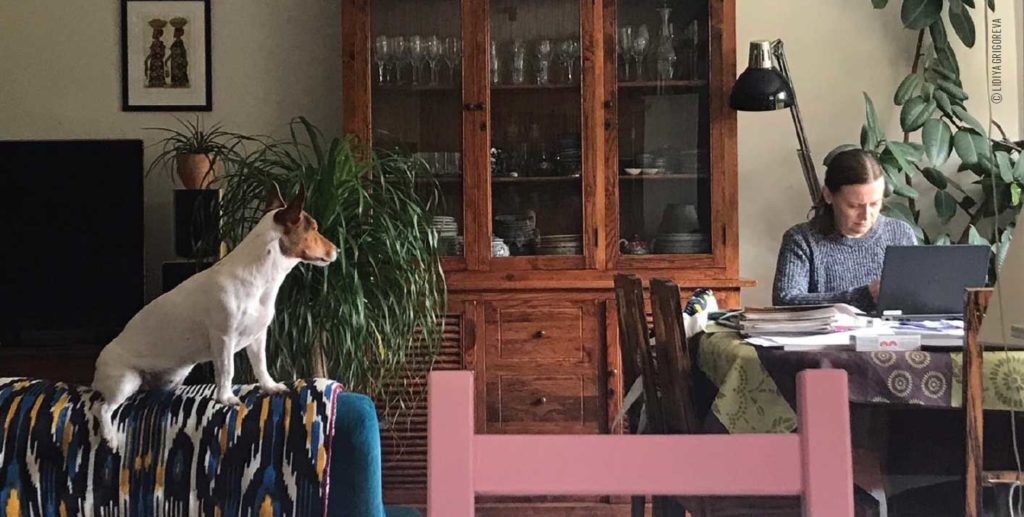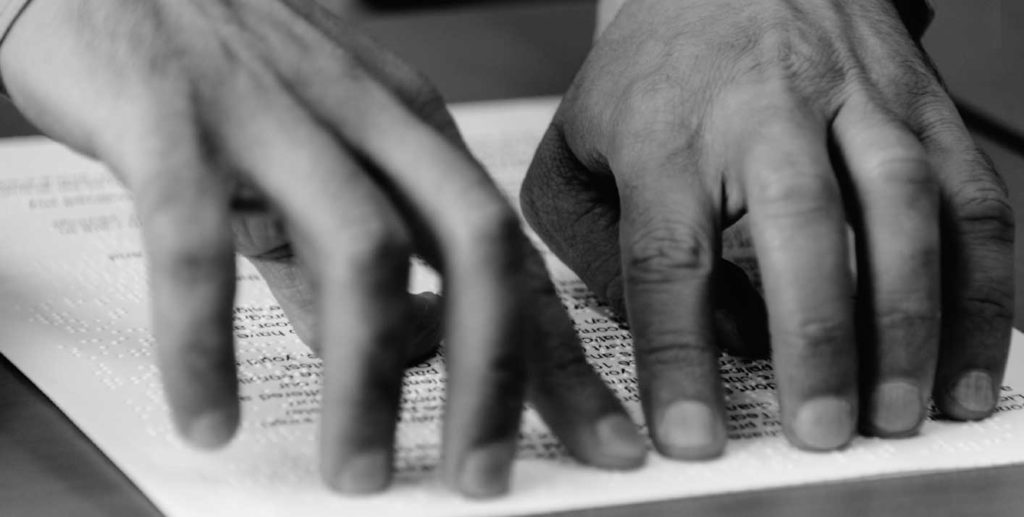The UN Today Editorial board selected these three photos that were deemed to be the best. Each photo is accompanied by comments from the Editorial Board, the author of the photo and the professional photographer, Geraldo Pestalozzi. Thanks to all participants for taking part in the contest and congratulations to the winners!

PHOTO 1
Comments from UNTODAY
This picture was selected for the “Working environment” category. It describes, in an extremely revealing manner, the everyday reality of UN workers since the beginning of the pandemic: there is no longer any distinction between our private and professional lives. The private sphere has become a professional space. The interplay between the foreground and background makes this colourful and joyous photo stand out.
Comments from the author, Lidiya Grigoreva, Political affairs officer, UNOG
“This is so wonderful that all humans in the family are at home all the time!” – this is probably what Laika, our dog, thought at the start of the confinement in March 2020, when we all found ourselves working and studying from home. Our living room became my office, and the dog is supervising all movements and gestures carefully.
Comments from photographer Geraldo Pestallozzi
Symmetry and geometry are the strong point of this photo. We have the big cupboard and the chair in the same foreground and the same background, in the centre of the image, in more vibrant colours, almost perfectly dividing the photo in the rule of thirds. Then we move on to symmetry. Each side has a living being placed in focus. The dog is centred on the woman focusing on her work, our eyes are directed in this direction. Both sides have plants in the background and the frame on the wall also shows two people, somewhat symmetrical, and is balanced by the computer.

PHOTO 2
Comments from UNTODAY
This photo was selected for the “My colleagues and I” category. It is in black and white and is very telling. It illustrates the difference between an outer world devoid of light (black), in which our visually impaired colleagues move, and that of the rest of us. The use of braille, contrary to what certain people might think, is possible at the United Nations. The fingers running through the text remind us of someone playing piano and the beauty and harmony that it evokes.
Comments from the author, Judy Hajoud Fadel-Ostojic, Arabic translator, UNOG
This photo is one of three photos I have picked because they represent major areas of interest to the Organization, one being accessibility. Why translating Braille? Transcribing is converting text to Braille*, but translating Braille, as stated in the caption, means conveying the sense of my photographic vision. I photographed the skill! Photography is not a matter of capturing, but rather a feeling, a constructive process in which we approach details that surround us from a different angle. In this image, I express the importance of skilled staff in the Organization. Reading Braille is a skill that I have chosen to make visible amongst the highly skilled workforce of the UN. Happy UN75!
Comments from photographer Geraldo Pestallozzi
These fingers are prepared to “walk” over information. Two languages are present at the same time. We know that the person with these hands will never see this image, but the colours are absent, thereby subtracting some information for the healthy eyes of the viewer. The fingers are not in focus, as we should expect. What is sharp is also hidden behind the hands and we can feel like blind people, hampered by the difficulty of fixing our eyes on crisp and clear information. We feel as if we are the blind person in the picture.

PHOTO 3
Comments from UNTODAY
This photo was selected for the “Missions abroad” category. It shows the importance of the work of the United Nations: coming to the aid of the needy in the fight against illiteracy. What is striking about this photo is the look of the adult in the eyes of the child. He is wearing borrowed adult clothes and this reinforces the impression that the subject is no longer a child. The colours of the child’s clothes match the framework around him and make this photo an outstanding success.
Comments from the author, Aziyade Louise Poltier Mutal, Head of the Perception Change Project, UNOG
A school student from Tessa, Niger. This photo was taken during a UN Goodwill Ambassador’s visit to the village of Tessa, about 100 km from Niamey. The visit to the village school was a great source of pride for the villagers. Schooling is free in Niger, but many areas do not have a school and, as a result, Niger has one of the lowest literacy rates in the world. This boy asked me to take a picture of him. The student is proud to be in this class and the perfectly written-on board behind him highlights the learning environment. I submitted this picture because it represents the positive result of technical assistance in developing countries and because access to quality education is one of the most powerful and proven vehicles for sustainable development.
Comments from photographer Geraldo Pestallozzi
The geometry of the picture is eye-catching. The colours are great, the boy has the same colours as the objects, dressed in black trousers (lower part) and light brown shirt (upper part). He is very centred and the black table frames his head. The lines forming the table, the stools and his body all move upwards. His feet, legs and body form an upwards triangle. All this geometry points to his head and he stares at us. We immediately establish eye contact. The vibrant colours come from the orange sandals, much bigger than his feet, as well as the clothes. We understand that he is using things that have been given to him, and the serious manner in which he looks at the camera gives the impression that he is committed to something, he is determined to get somewhere and we imagine that he is able to take advantage of the opportunities he has.



